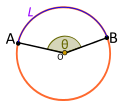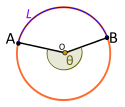Central angle

A central angle is an angle whose apex (vertex) is the center O of a circle and whose legs (sides) are radii intersecting the circle in two distinct points A and B thereby subtending an arc between those two points whose angle is (by definition) equal to that of the central angle itself.[1] It is also known as the arc segment's angular distance.
When defining or drawing a central angle, in addition to specifying the points A and B, one must specify and/or denote whether the angle being defined is the convex angle (<180°) or the reflex angle (>180°).
- The size of a central angle Θ is: 0°<Θ<360° оr 0<Θ<2π (radians)
Formulas
- If the intersection points A and B of the legs of the angle with the circle form a diameter, then Θ=180° is a straight angle. (In radians, Θ=π.)
Let L be the minor arc of the circle between points A and B, and let R be the radius of the circle.[2]
 |
| Central angle. Convex. Includes minor arc L |
- If the central angle Θ includes L, then
Proof (for degrees): The circumference of a circle with radius R is: 2πR, and the minor arc L is the (Θ/360°) proportional part of the whole circumference (see arc). So:
 |
| Central angle. Reflex. Does not include L |
Proof (for radians): The circumference of a circle with radius R is: 2πR, and the minor arc L is the (Θ/2π) proportional part of the whole circumference (see arc). So:
- If the central angle Θ does not include the minor arc L, then the Θ is a reflex angle and:
- If a tangent at A and a tangent at B intersect at the exterior point P, then denoting the centre as O, the angles ∠BOA (convex) and ∠BPA are supplementary (sum to 180 °).
See also
References
- ↑ Clapham, C.; Nicholson, J. (2009). "Oxford Concise Dictionary of Mathematics, Central Angle". Addison-Wesley. p. 122. Retrieved December 2013.
- ↑ "Central angle (of a circle)". Math Open Reference. 2009. Retrieved December 2013. interactive
External links
- "Central angle (of a circle)". Math Open Reference. 2009. Retrieved December 2013. interactive
- "Central Angle Theorem". Math Open Reference. 2009. Retrieved December 2013. interactive
- Inscribed and Central Angles in a Circle



